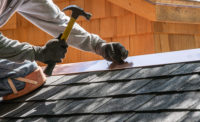In recent years, technology advancement has allowed manufacturers to create more sophisticated yarns that improve glove performance significantly. The level of cut protection can be increased by using high-performance materials (Kevlar®, Dyneema®); composite yarns made with fiberglass, steel, or synthetic materials; and by increasing a material’s weight measured in ounces per square yard.
The benefit of using heavier gloves is that they provide extra protection against cuts, puncture, and abrasion, as well as durability. Lightweight glove styles offer more dexterity and reduce hand fatigue. Coated gloves have enhanced grip capability and high levels of cut protection.
Scope of standard
ANSI/ISEA 105-2016 addresses the classification and testing of hand protection for specific performance properties related to mechanical protection (cut-resistance, puncture-resistance and abrasion-resistance), chemical protection (permeation-resistance, degradation) and other performance characteristics such as ignition resistance and vibration reductions.
Key definitions
Two major global standards are used to evaluate the protection levels of work gloves:
- ANSI/ISEA 105 (U.S. Standard) and EN 388 (EU Standard). EN 388 is also commonly cited in other parts of the world such as Canada, AUS/NZ and South America. In 2015-2016, significant changes were made to both.
- A cut is typically thought of like a wound caused by a sharp object (such as a knife or a shard of glass).
- Laceration implies a torn or jagged wound. Lacerations tend to be caused by sharp objects. Cuts and lacerations are terms for the same condition.
Key standard takeaways
- Gloves are classified to a performance level ranging from 0 to 6 based upon their performance when evaluated against defined industry test methods. Such ratings assist users to select appropriate hand protection for known specific hazards in the workplace.
- One of the major changes in ANSI/ISEA 105-2016 is the determination of classification for cut-resistance, including the use of a single test method for testing in an effort to provide consistent meaning of the ratings from the end-user perspective. Classification levels have been expanded to address the gap among certain levels seen in earlier versions and to model the approach used in similar international standards.
- Under the previous standard, cut levels were broken up into five levels; Cut Level 1 (rarely promoted across the industry), Cut Level 2, Cut Level 3, Cut Level 4 and Cut Level 5. Under the new ANSI/ISEA 105 standard, there are nine (9) levels of cut protection. Additionally, all levels reference “A” as a prefix to identify compliance with the new standard. These levels are: Cut Level A1 (similar to the old standard’s Cut Level 1; it is anticipated that this too will be rarely promoted), Cut Level A2, Cut Level A3, Cut Level A4, Cut Level A5, Cut Level A6, Cut Level A7, Cut Level A8 and Cut Level A9.
- The ANSI/ISEA 105 2016 standard contains a new cut protection test: ASTM F2292-15. In this test a machine known as a tomodynamometer, or TDM, pulls a blade in 20mm paths across a glove’s surface under varied gram loads and measures the weight needed to cut through.
Cuts and lacerations treatment
According to WebMD, call 911 if:
- A cut is bleeding severely;
- Blood is spurting out;
- Bleeding can't be stopped after 10 minutes of firm and steady pressure.
In general, a cut that needs stitches should be repaired within 6 hours of the injury.
For minor cuts:
1. Stop the bleeding
- Apply direct pressure on the area.
2. Clean and protect
- Clean the area with warm water and gentle soap.
- Apply an antibiotic ointment to reduce chance of infection.
- Put a sterile bandage on the area. In some people, antibiotic ointments may cause a rash. If this happens, stop using the ointment.
3. Call a health care provider
Call a health care provider if:
- The cut is deep or over a joint;
- You cannot get the cut or laceration clean;
- The injury is a deep puncture wound or the person has not had a recent (within the last five to ten years) tetanus shot or booster;
- The cut is from a human or animal bite;
4. Follow up
- For a minor cut or laceration, remove bandage after a couple of days to promote healing.
- See a health care provider if the cut doesn't heal or shows signs of infection, including redness, swelling, pus, or excessive pain.
From the size of the wound to its location, according to WebMD there are many signs that you need stitches or at least to have a doctor check things out.
How big is it? You’ll want to see a doctor if the wound:
- Looks very deep, even if it’s not especially long or wide;
- Is more than a half-inch long;
- Opens so wide that you can’t get the edges together with just a little pressure;
- Has ragged edges;
- Has debris in it such as dirt, glass, or gravel.
How badly is it bleeding? You’ll likely need stitches if the wound:
- Bleeds enough to soak through a bandage;
- Keeps bleeding even after you apply direct pressure for five to ten minutes;
- Spurts blood.
What caused it? For some wounds, you may need a tetanus shot as well as stitches. Adults need a booster every ten years.
Get care right away if the wound is from an:
- Animal or human bite;
- Dirty or rusty object;
- Pointed object that might have driven deep into the skin, such as a nail.
Is it getting infected? See a physician if there are these signs of infection:
- Chills or fever of 100˚F or higher;
- Red streaks near the wound;
- Skin gets redder or more painful;
- Sore is warm, swollen, or oozing pus;
- Feeling like you’re going to throw up.



